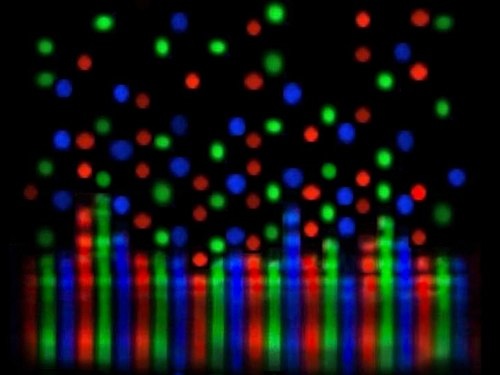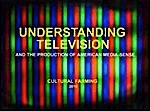Can you discuss one of your videos?
I care little about entertaining an audience, or even cultivating an audience. My video essays are cultivating a practice. So I care even less about proselytizing more ideological pablum. Instead, I insist upon interrupting and antagonizing normative, passive, media production and immersion. This method allows critical spaces for myself and for viewers to consider their own thinking processes, while watching these innumerable video fillips collide. From this vantage, each video is an experiential writing form -- ethnographic surrealism -- hand-fashioned into a Cultural Farming aesthetic (ekphrasis) for unveiling our mediating worlds.
“Unlike Aristotelian tragedy, imitation is no longer the goal, since that affords the ‘space of seduction’ between spectator and spectacle.”
Understanding Television isn’t simple repetition, or a mere doubling of problems. I confound the double-bind of mimesis by mixing into this stew, methods of Artaud's theater of cruelty, a “half-way point between thought and gesture.” This for Cultural Farming vexes the gap between the closed worlds of media-making and media-consuming. It cracks open new fruitful terrains of exchange. This method of practical disection opens dialog and provokes critical (dialectic/dialogic/didactic) modes of understanding.
Each response is fashioned into a return gift --given back to media makers-- for reflecting upon their own ‘crimes against real’. Now, they can see what it is I am seeing and notating and archiving... and exactly why I’m doing it, in this particular way. This is not armchair interpretation, it is a (C)ritical ethnographic method for presenting empirical material longitudinally observed and collected within a particular culture. It is an accurate ‘showing & telling’.
I do this because TV is no longer ‘looked at’ with concentrated attention. Because it is everywhere, in every direction. Television is moving wallpaper, inescapable, now perceived as Walter Benjamin noted, in a state of (mechanical) distraction. Cultural Farming methods, if nothing else, provide a critical practice for ‘waking up’ from this mediated hypnosis. As Douglas Kellner (2001) writes:
“...a television studies that is critical and multicultural provides comprehensive approaches to culture that can be applied to a wide variety of artifacts -- from a TV series to phenomena like Madonna, from MTV to TV news, or to specific events like the 2000 U.S. presidential election, or media representations of the 2001 terrorist attacks on the U.S. and the U.S. response.
“Its comprehensive perspectives encompass political economy, textual analysis, and audience research and provide critical and political perspectives that enable individuals to dissect the meanings, messages, and effects of dominant cultural forms.
“A critical television and cultural studies is thus part of a media pedagogy that enables individuals to resist media manipulation and to increase their freedom and individuality. It can empower people to gain sovereignty over their culture and to be able to struggle for alternative cultures and political change. Cultural studies is thus not just another academic fad, but can be part of a struggle for a better society and a better life.”
TOPICS -- THEMES -- CONSTRUCTION
Topics vary widely in Understanding Television, with numerous televisual currents (convolutes) running throughout, for instance: image making, cameras-screens-guns, media history & technology, communication & journalism, poetry & jazz, and Potlatch.
Any video may also loop a host of sub-themes like: telephones, politics, gaming, consumption, fashion, fear & death, business, feminism, education, religion, children, medicine, human bodies, language, celebrity, food production, pornography, robots & drones, military & war, surveillance & privacy, dance, race & gender, nature & animals, virtual & live events. etc.
Nevertheless, every video illustrates particular methods of resistance against the amplified intentions (the ethics) inherently resident inside the ‘productions of production’ of most all televisual media. This is the stuff Understanding Television aggregates, for these continually conflate towards (lethal) collective allegiances of ‘common sense’.
Many videos here share similar technics. But there are differences. LINKED HERE AGAIN, this particular video for discussion is a bit unusual in that it is split equally into halves. The first portion is content ripped entirely from just one hour-long History Channel program. I discarded most of its pathetic futurist excrement, but aggregated the hyper-amplified visuals I wanted to re-function.
I then inserted non-diegetic contrapuntal audio accompaniment. I happened to hear it on TV just the night before. This orchestral music is from a feature film entitled Another Earth and composed by Fall On Your Sword. I remembered that I had liked it. So I appropriated this music, primarily because it provided an excellent scaffold for me to edit through, and also it was approximately the same length as the visual junk I had just gathered. Then, once situated with a wee bit of structure in place, Montage proceeds: simultaneous, linear, rhythmic, free-form, chance, automatic writing, interruption, call and response, jazz, rap, tap, scat... each an ethnographic writing of the ecstasies of communication, each personally witnessed, each exactly 30 minutes in length.
FIRST HALF -- MINUTES 0-15
The first half of this video essay intends to craft an imagistic Tone-Poem, mirroring the grotesque rush of living and moving creatures our obedient society races to passively accept. Every image here is, of course, wholly fictional, created by numerous anonymous media makers (designers). Each image is created well beyond the scope of any human experience or understanding. Left to their own devices, these images are lethal: spectacular, ungodly, dangerous, antihical to earth and being. Horribly fictional.
The exercise here is not to cleverly re-edit this material to a musical beat, or to simply mash-up still more compelling imagery. Rather, the challenge is to edit-away the unwanted parts of this hideous docu-lie, while positioning the remaining bits into another alternative, intentional, ready-made dreamscape. This highjacks whatever original intention, and (re)performs a kind of dialectical reversal, a rejection, an irreverence, which communicates from a much sharper critical orientation. Once media interpellations are are returned intellectually, it affords permission to turn one’s back to this crap again in the future.
“This is Surrealism and Fair Use put to good work. It is Cynicism well spoken, and ‘magical aura’ reconsidered.”

SECOND HALF -- MINUTES 15-30
“I want you so bad, it’s driving me mad, its driving me mad.”
The second half of this same VIDEO is more difficult. It centers around the very recent Paris/ISIS terrorist massacre (13Nov15). I made this video as it simultaneously spilled into my home as LIVE TV -- while network employees wittingly amplified real fear and confusion with (lethal) non-sensical TV production methods: Voice-overs, locked-down cameras, scrolling incorrect information. Yet these methods are believed to be proven, to be the most accurate and understandable, to be properly palatable for consumption. Of course, the opposite is true.
This portion of my video is not meant to shock, rather it should elicit shame -- shameful memories of how we so eagerly produce and devour ever-increasing horror, as spectacular entertainment under the guise of news & information. This portion of the video brackets the utter backslide of “journalism’s” ethical purpose. This is how ‘news’ is continuously produced --exactly like this-- throughout most televisual journalism today. We no longer seem able to see this. No wonder we’re dumb as bricks.
Unfortunately, I have previously recorded many similar events (1, 2, 3). With each daily death-event, standard TV production simply goes into round-the-clock stasis. All else is excluded. Shock and anecdote are championed over factuality. Repetition signals reptilian cognition. We eagerly ingest another media spectacle with mouths agape, awaiting the next dosage of magic bullets from very real hypodermic algorithms openly administered by a very real and growing Surveillance State.
Nothing could be worse, right? Wait...how about we all attach our cameras to miniature helicopters! Neat...another new form of gun...or is this a winged opioid? Good question.
“We eagerly ingest another media spectacle with mouths agape, awaiting the next dosage of magic bullets from very real hypodermic algorithms.”
Unnervingly, this video points to many worse televisual-events to come, probably in the next ten minutes. If so, we can be sure each will also be instantaneously ‘analyzed and produced’ -- quite likely cozened for profit by humans and machines right in your own neighborhood. Hundreds of humans with their trigger-fingers on top of mountains of machines, all ‘gaming’ toward total emotional effect by maximizing any technological trick to further hypnotize and manipulate. The goal? To entice the correct consumer response within every available viewer. Gotcha. “Thank you Mr. TV, may I have another?” You sure as hell can.
“She’s so heavy.” ...but how do “she” and “heavy” mean?
Critical insight from intellectual editing choices truly begins to occur during the act of its re-production, and in the case here, by slowing down both music and image to an other-worldly speed. We know this music very well, our whole lives maybe, only now it is oddly different, conjuring fresh connectivities. It deliberatively rubs against the grain of the non-stop horrific (throwaway) live image stream. Each (audio + video) begins to imbue the other, to re-charge the other with possibility, to free it from “common sense” understanding. We begin see differently, and to form our notions for ourselves.
This is only one simple but effective technique for making strange (Verfremdungseffekt). While there are hundreds of individual edits in this 30minute video, all are attempts to elicit a new transparency, a truer personal memory. Because we now too often willfully exclaim, “It was surreal... just like a movie!”. Indeed, there is little else we know how to say. And we happily turn away, just to face another media screen, one after another, always conflating actual with its mediated appearance.

2. How should viewers watch these video essays?
3. Introduction to the research.
4. What does understanding television mean?
5. How do I understand television?
6. What does using theory mean?
7. Can you discuss one of your videos?
8. What was discovered in this research?
9. What if viewers still don’t ‘understand’ television?
An American
resident of Canada, experimenting with new forms of critical media ethnography in Cultural Farming



